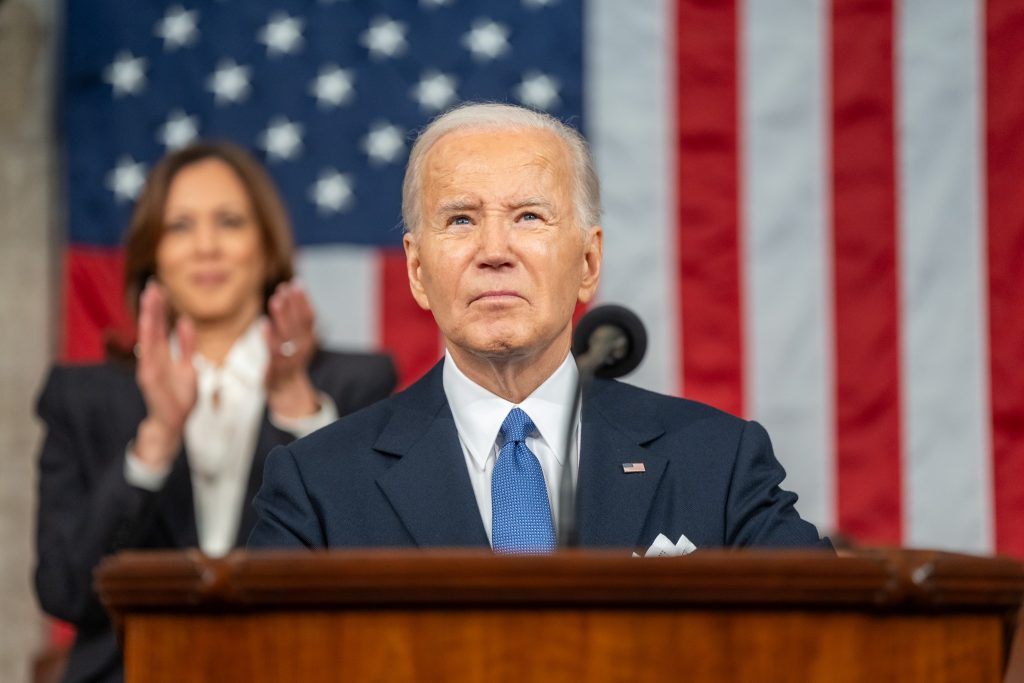
Leading up to the March 7 State of the Union speech, Biden supporters were scared. They had every reason to be.
The President’s approval rating had dropped from 42% to an abysmal 38%, even lower than ex-President Trump’s before the January 6 riot. Biden’s stance on the Israeli-Gaza conflict was losing him support from the left wing of his party. A Special Counsel for the Justice Department investigating Biden’s handling of classified documents called him ‘an elderly man with a poor memory’. With every court case going against Trump – last month he lost decisions resulting in fines to New York State of $453 million and to writer E. Jean Carroll of an additional $85 million – his supporters grew more committed and his control of the Republican Party more iron-clad.
And every day, the 81-year-old Joe Biden was getting older.
The atmosphere in the House Chambers on March 7 was tense and adversarial. Democrats and Republicans hardly socialized with one another, which isn’t usually the case: Senators and Representatives at a SOTU speech make at least a token effort to look collegial. Democratic women dressed in suffragette white in support of reproductive rights that had been lost by the repeal of Roe v. Wade; Republican women wore buttons emblazoned with the name ‘Laken Riley’, a young nurse who had been killed that morning by an undocumented immigrant.

Official White House Photo by Adam Schultz. Source: Wikimedia Commons
So the speech carried more weight than usual. Everybody knew that whatever the President said mattered less than how he said it. Perhaps more than any other speech in Biden’s career, this one would be a matter of optics, a spotlight on the inevitable comparisons to his rival in the upcoming Presidential race: Who looks younger? Who looks stronger?
Biden came out fighting. The first minutes of his 68-minute-long speech were the most political, and the most effective. Calling Trump ‘my predecessor’ rather than referring to him by name, he maintained that the ex-President had ‘bow[ed] down to a Russian leader’ in his disregard for the Ukrainian cause, and that ‘January 6 … posed the greatest threat to democracy since the Civil War’.
The rest of the speech was more within the usual parameters: a laundry-list of the administration’s accomplishments and grandiose proposals for future legislation that have no chance of getting through a bitterly divided Congress. But optics trumped substance. The last hour was nothing more or less than a televised stress-test before 32.8 million sceptics: Could the President speak at length without getting exhausted or confused? Were the doubts about his health, competence and age justified or exaggerated?
If the relieved looks on the faces of tv commentators were any indication, Biden did better than expected: he looked like he had enough vigour to keep him out of a rest home for the foreseeable future. But whether the relief lasted more than a few hours – or whether the speech allayed the doubts of the general public – is quite another matter.
*
Several issues that have arisen or intensified during the past year have also contributed to Biden’s dismal approval ratings.
Though a majority of US citizens are still behind military support of Ukraine, recent Gallup and NBC polls indicate that many believe there should be a time limit; in the past few months, Republicans blocked bills to allocate new funds. J.D. Vance, a first-term Senator from Ohio who is fast emerging as the most articulate of Trump supporters, has taken a public stance that even massive amounts of support won’t win the war; that the West simply can’t match the production of Russian ammunition and weaponry, and that a negotiated settlement is inevitable. It’s an ominous view that is quietly gaining traction, and we can expect to hear it from Trump’s mouth in the coming campaign.
Biden’s stance on the US southern border is even shakier.
During his early months in office, the President loosened Trump’s more Draconian border regulations and halted construction on the Wall. Illegal immigration soared to an average 2 million annually, and the Governors of Texas and Florida started shipping bus- and planeloads of undocumented immigrants to sanctuary cities like New York and Chicago. In turn, mayors flocked to Washington to appeal for Federal funds – which they didn’t get. Tensions arose even among factions who were sympathetic to undocumented immigrants, and Biden started back-tracking.
It has been the most visible misstep of the President’s tenure. As Biden waffled – he built a small part of Trump’s planned Wall – rightwing media produced videos of immigrants cutting through barbed wire at border crossings. When the President finally marshalled bipartisan support for a tougher border bill, Trump instructed Republican Senators to vote against it. Now both sides have mud to sling at each other: Biden will call out the Republicans for undermining a bill they clamoured for, Republicans will chide the President for being ‘weak’ on immigrants until he saw that public opinion was against him.
All this surfaced in the State of the Union speech. Wearing a bright red MAGA outfit, Marjorie Taylor Greene, the far-right Representative from Georgia, shouted out the name of the murdered nurse. Later, in the televised Republican rebuttal to the speech, Alabama Senator Katie Britt sat at her ‘kitchen table’ weeping crocodile tears for all the moms who fear that their kids will be attacked by undocumented immigrants. (Her appearance was later parodied brilliantly by Scarlett Johannson on Saturday Night Live.)
The Israel–Hamas conflict is another area where US opinion is deeply split, this time by age: a majority of older voters support Israel, while under-45 voters support Palestine. As one radio commentator said: ‘To an older generation, Israel is David; to a younger generation, Goliath.’
So Biden has a narrow row to hoe.
In the days immediately after the October 7 massacre, the President took his usual strong position in support of Israel. But as the number of Palestinian casualties increased and the administration’s negotiating skills proved less than effective, Biden moved to a ‘centrist’ position that currently pleases no one.
In the SOTU speech, he tried to counterbalance condemnation of the Hamas attacks with criticism of the Israeli response, and announced the construction of a pontoon bridge on the Gazan coast. But the damage had already been done. In last week’s Democratic primaries, 20% of voters in Minnesota and 13% in Michigan voted ‘uncommitted’ in protest at Biden’s Israel–Gaza policy. The President desperately needs those votes in November; in 2020 he won most of the electoral votes in both states, but only by narrow margins. It’s very possible that a large percentage of those ‘uncommitted’ voters will sit out the Presidential election entirely.
Unsurprisingly, Trump has remained silent about the War – except to say that he could end it in 24 hours.
*
Which brings us to the elephant in the room – not exactly Trump or his policies, but a sense that an irresistible tide is carrying the Trump campaign forward, and nobody can do a thing to stop it.
Consider the results of a late February New York Times/Siena poll, in which 48% of the participants said they would support Trump for President, while only 43% were behind Biden. Only 83% of those who supported Biden in 2020 would vote for him in 2024, while 97% of Trump’s 2020 supporters would vote for him again. As few as one in four voters felt that the country was headed in the right direction. Even though unemployment in the US is down to 3.1%, wages are up, the Stock Market has reached new highs, and inflation has slowed to 3.7% from a peak of 8.5%, a majority of Americans feel that the economy is in bad shape; stubbornly high food prices may prove to be a major factor in the 2024 election. Only 23% are ‘excited’ about Biden, while 46% say the same about Trump; 32% are dissatisfied with or angry at Biden as the head of his party, while only 18% are dissatisfied with Trump.
With eight months to go before the election, statistics like these – for all their limitations – are worrisome
What has Trump been doing the last few months? When he wasn’t putting in appearances at one or another of his court proceedings – at present he has 91 felony charges against him in four different cases – the ex-President campaigned against his chief rivals Ron DeSantis and Nikki Haley, both of whom he defeated handily in all but one Republican party primary. While the New York Times/Siena poll indicated a lack of support among suburban and college-educated voters, Trump has picked up strength among Black and Latino voters, and especially among women – constituencies that Democrats could depend on as recently as the 2022 midterm elections.
Whether the Trump tide is inevitable – and despite the caveat that a criminal conviction against him could change the whole face of the election – the fact remains that the Democrats have lost touch with their base, and Trump has been able to maintain his image as the voice of national discontent. The less he says about actual policy, the better. In Trump’s first term, his policies didn’t amount to much more than populist isolationism and business-oriented pragmatism.
The fact that Senator Britt’s rebuttal of the SOTU speech made absolutely no mention of Trump suggests that his policies, or even his physical presence, aren’t vital to his re-election. (It’s possible that he’ll bypass the Presidential debates just as he bypassed the Republican primary ones.) What millions of people seem to want is not Trump but his meme – a ‘strong man’ voicing inchoate rage.
It isn’t clear how the Democrats should respond. Logic and a recitation of political accomplishments won’t work. Even though some of the bills Biden got through Congress directly benefitted Trump supporters, that isn’t how this group perceived them. Can any approach change the minds of such a hardened constituency, and at the same time appeal to the 10% of ‘undecided’ suburban, college-educated voters, many of whom are moderate Republicans repulsed by Trump?
Though Biden may have passed the stress test of the SOTU speech, his supporters will and should remain very, very scared.
Source link




